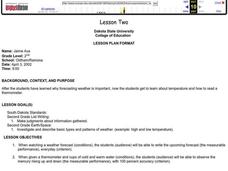Curated OER
Heat Transfer
Answer short answers and fill-in-the-blank questions after reading a briefing of how heat energy is transferred between objects. This straightforward instructional activity can be useful as homework the evening before you do...
Curated OER
Making a Thermometer
Students observe a demonstration of how a thermometer functions. They apply the scientific method while determining which of three cups hold the coldest water. They write a hypothesis before conducting the experiment and gather data.
Curated OER
Celsius or Fahrenheit?
Students compare and contrast the two measurement scales of Fahrenheit and Celsius. They calculate the temperature using both measurements. Students demonstrate their comprehension of these systems by creating a dual-system thermometer...
Curated OER
Unit 0 Review - Measurement Lab Equipment
Review questions like these can be used in your biology, chemistry, physics, or earth science classes! They assess scientists' understanding of laboratory measurement tools including graduated cylinders, thermometers, and balances. They...
Curated OER
Weather Instruments
Middle school meteorologists get acquainted with basic weather instruments: the thermometer, barometer, psychrometer, and anemometer. For each, the question is asked, "Do you think you can make a _______________?" At these points, you...
Curated OER
Heat - A Form of Energy
Middle school or high school physical science pupils will warm up to the topic of heat when viewing this set of slides. It covers heat transfer, measurement tools, phase changes, and more. Have demonstrations and examples of the tools...
Curated OER
Negative Numbers
Sixth and seventh graders investigate the concept of negative numbers. The lesson begins with a review of positive numbers and progresses to the various operations with negative numbers. The lesson includes dialogue for the teacher to...
Curated OER
Keeping Warm
There are five separate lessons about heat in this collection of slides. Young scientists learn how to use a thermometer to measure temperature, and they experiment with insulators. You can use one of these lessons each day for a full...
Curated OER
Discovering Math: Beginning Measurement
Young mathematicians are shown a ruler, yardstick, tape measure and scale. They practice measuring length, width, height, and weight. They are then shown a thermometer, and discuss what a thermometer is used for. Everyone is shown how to...
Curated OER
Hickory Dickory Doc Tell Time
Learners discover time keeping by reading clocks. In this time-telling instructional activity, students read the story Hickory Dickory Dock, and discuss the measurements of time we use. Learners complete worksheets in which they...
Curated OER
Lesson Two
Second graders, after assessing why forecasting weather is important, study about temperature and how to read a thermometer. They experiment being able to observe the mercury rising up and down when given a thermometer and cups of cold...
Curated OER
Weather Tools
Ever wonder how scientists measure shifts in weather? Share the answer to this question with a clearly organized slide show depicting various weather tools. Included are images and definitions for a barometer, thermometer, rain gauge,...
Curated OER
Weather Observations
Students record the weather using an outdoor thermometer. In this weather instructional activity, students compare their recordings to that on the weather map online. Students explain the differences of each weather reading. Students...
Curated OER
Global Warming Experiment
Students examine the changes in Earth's temperature. In this global warming lesson, students perform an experiment testing temperatures of soil. Students record their findings and discuss what made the differences in the soil temperature.
Curated OER
Hot n' Cold
Students keep a weather log. For this weather and temperature lesson, students discuss the information that can be obtained from a map and lead into a discussion about temperature. Students watch a video about temperature and...
Curated OER
Taking the Temperature
Students read a thermometer in Celsius and Fahrenheit. In this thermometer reading lesson, students take the temperature in different situations and discuss the results with a partner.
Curated OER
Use Temperature
In this temperatures worksheet, students read 7 clues and use their answers to fill in the temperature chart. All problems pertain to the rise and fall of temperatures in five cities.
Curated OER
The Great Heat Escape
Students observe a demonstration on the role of thermal conductivity in heat transfer. In this thermal conductivity instructional activity, students design and conduct an experiment to compare the thermal conductivity of four...
Curated OER
Weather With a Latitude
Young scholars read the temperature from a thermometer. In this weather lesson, students read a thermometer and record the temperature at twenty minute intervals. Young scholars discuss results.
Curated OER
Measuring Units and Tools
In this measurement instructional activity, students determine which of 3 measurement tools would be used to answer 4 mathematical questions. Students circle their multiple choice answers and then draw or write an explanation for each...
Curated OER
Problem-Solving Application: Use Temperature
For this temperature problem solving worksheet, students read a story problem about the temperature variations in one day. Students answer 4 questions in which information they know is organized and a plan is made to calculate the...
Curated OER
Thermometers
In this thermometer worksheet, learners fill in the thermometers. The worksheet provides 2 blank thermometers which can be used for a variety of different math or science lessons.
Curated OER
Science Experiment: Take a Rainbow's Temperature
In this science experiment worksheet, students gather materials and perform an investigation using thermometers and prisms. Students are asked if red is hotter than blue. They answer 6 questions.
Curated OER
Science: Let's Have a Cool Lunch
First graders develop problem-solving skills by designing methods for keeping lunch boxes cool. Once they determine the amount of sunlight and heat generated in shaded and unshaded areas, they explore ways to provide shade. Finally, 1st...

























